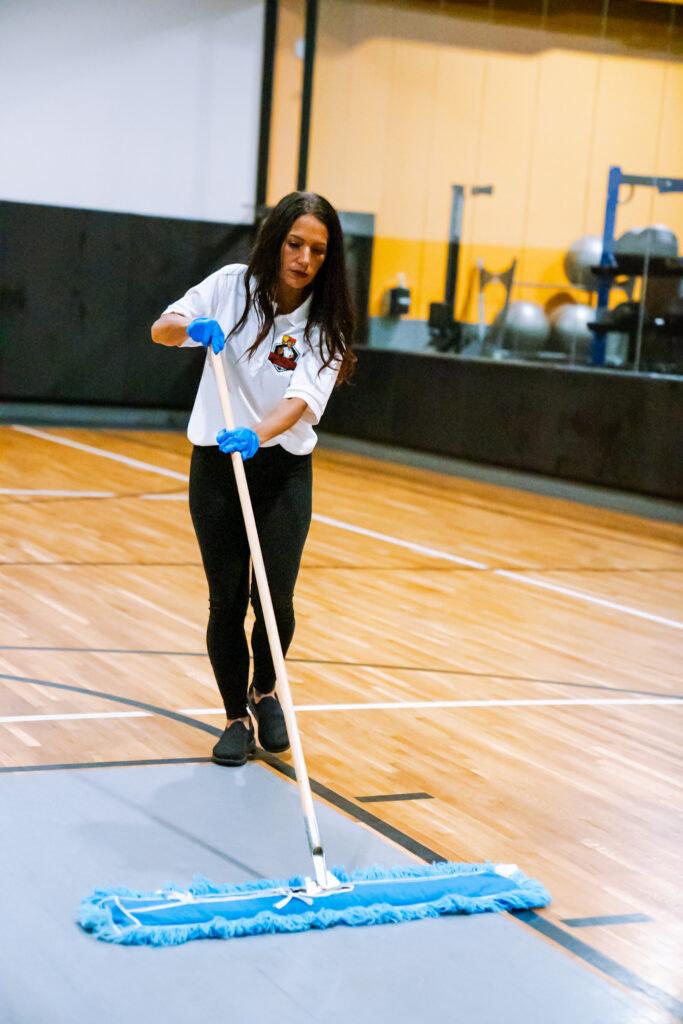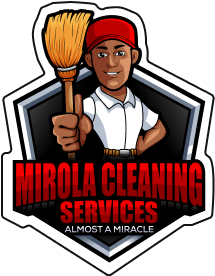How to remove adhesive residue from floors is a question many homeowners and business owners face after renovations, repairs, or simple DIY projects. Picture this: you’ve just peeled off old tiles, carpets, or stickers, but instead of a clean surface, you’re left staring at sticky patches of dried glue clinging stubbornly to your floor. The excitement of a fresh look quickly turns into frustration.
The cause is simple. Adhesives are designed to bond strongly, often penetrating tiny pores in wood, tile, or vinyl. When the surface covering is removed, parts of the glue remain embedded. If left untreated, these residues attract dirt, discolor the floor, and even create tripping hazards. In offices or childcare centers, leftover adhesive can compromise both appearance and safety.
At Mirola Cleaning, we’ve helped countless clients like you to restore their floors, and we know this sticky problem is common. The good news? There are practical methods to solve it. Below, we’ll walk you through different removal patterns, starting with the toughest professional-grade solutions down to the simplest home remedies.

1. Professional-Grade Solvent Cleaning (Hardest but Most Effective)
When adhesive residue is thick, stubborn, or has hardened over time, professional-grade solvents are often the most reliable solution. Products like adhesive removers, mineral spirits, acetone-based cleaners, or commercial degreasers work by breaking down the chemical bonds that keep glue firmly attached to flooring surfaces. This method is especially useful after large projects such as carpet or vinyl tile removal, where layers of glue remain stuck to concrete, wood, or ceramic.
How to use this method:
- Wear protective gloves and ensure proper ventilation, as these products release strong fumes.
- Apply the solvent directly to the adhesive, covering it evenly.
- Allow it to sit for the manufacturer’s recommended duration, usually 10–20 minutes, so the chemicals have time to penetrate.
- Once softened, scrape carefully with a putty knife or floor scraper. Work slowly to avoid scratching hardwood or tile.
- After removing the glue, rinse the floor thoroughly with warm water mixed with mild soap to eliminate any leftover chemical residue.
Why this method works:
Professional-grade solvents are formulated to cut through industrial-strength adhesives that water, vinegar, or heat cannot handle. They dissolve even old glue that has hardened for years, saving time and effort.
Caution to note:
While effective, this method demands careful handling. Harsh solvents can discolor or damage delicate flooring like hardwood if left too long. Always test on a small hidden area before full application. For best results on sensitive floors, hiring professional cleaners like Mirola ensures the glue is removed without harm to the surface.
2. Heat Treatment with a Heat Gun or Hair Dryer
Heat is another proven way to loosen adhesive by softening its bond to the floor. When exposed to controlled high temperatures, the glue becomes pliable, making it easier to scrape off. This method works well for vinyl, tile, laminate, and even some types of sealed hardwood floors where chemical solvents may be too harsh.
How to use this method:
- Plug in a heat gun or a high-powered hair dryer and set it to medium or high heat.
- Hold the device 3–5 inches away from the adhesive, moving it back and forth to distribute heat evenly.
- After 2–3 minutes, test the glue by pressing lightly with a scraper—if it feels soft, it’s ready.
- Gently scrape the adhesive with a plastic scraper or putty knife, lifting it layer by layer.
- Once removed, clean the surface with warm, soapy water to clear any residue.
Why this method works:
Adhesives are designed to hold firm at room temperature but lose strength when heated. By softening the glue, heat allows you to separate it from the floor without relying on strong chemicals. This makes it a safer option for those concerned about fumes or chemical exposure indoors.
Caution to note:
Excessive heat can cause damage. Vinyl may warp, laminate can bubble, and hardwood finishes can discolor if overheated. Always keep the heat source moving and avoid holding it in one spot for too long. For larger areas or delicate flooring, professional cleaners like Mirola use specialized tools that apply the right level of heat without risking floor damage.
3. Scraping with Hot Water and Soap
Hot water is a safe and effective first step for medium-strength adhesives that haven’t fully hardened. The heat softens the glue, while soapy water helps loosen its grip on the floor surface.
How to use this method:
- Heat water until it’s hot, but not boiling, to avoid damaging the floor.
- Pour or spray the hot water directly onto the adhesive patch.
- Let it sit for 5–10 minutes so the glue absorbs the moisture.
- Use a plastic scraper, scrub brush, or sponge to lift the softened glue.
- Wipe the area clean with a fresh cloth dipped in warm, soapy water.
Why this method works:
Hot water penetrates and breaks down weaker adhesive bonds, especially those used under carpets or lightweight vinyl tiles. Adding soap reduces stickiness and makes scrubbing easier.
Caution to note:
This method may take multiple rounds for thicker adhesive. Avoid flooding wooden floors with water, as it may seep into the wood and cause swelling. A dampened towel soaked in hot water and placed over the glue works better for hardwood.
4. Vinegar or Citrus-Based Cleaners
Natural acids and oils are excellent for light adhesive residues or sticky spots left by tapes and stickers. Vinegar cuts through the glue’s surface layer, while citrus oils break it down and leave a pleasant smell.
How to use this method:
- Spray white vinegar or a citrus-based cleaner directly on the adhesive.
- Let it sit for about 10 minutes to soak into the residue.
- Use a soft-bristle brush, sponge, or microfiber cloth to scrub gently.
- Rinse with warm water and wipe dry.
Why this method works:
Vinegar and citrus are mild solvents that dissolve adhesives without harming most flooring. They’re eco-friendly, non-toxic, and affordable, making them a popular choice for quick household fixes.
Caution to note:
While safe for tile and vinyl, vinegar is acidic and may dull natural stone surfaces like marble or granite. Always test in a small hidden area first. For delicate surfaces, stick to citrus-based cleaners.
5. Baking Soda Paste
Baking soda acts as a mild abrasive and a natural deodorizer, making it useful for removing small sticky spots without harsh chemicals. It’s especially effective on delicate floors that might scratch or discolor with stronger methods.
How to use this method:
- Mix baking soda with a little water to form a thick paste.
- Spread the paste over the adhesive residue.
- Allow it to sit for 5–10 minutes.
- Scrub gently in circular motions with a sponge or soft cloth.
- Wipe clean with warm water and dry with a towel.
Why this method works:
The fine grains of baking soda lift glue from the surface without scratching, while the paste traps and absorbs the residue. It’s safe, non-toxic, and easy to prepare at home.
Caution to note:
This method is best for light residues. For larger or hardened glue patches, it may not be strong enough on its own. In such cases, pair it with hot water or vinegar for added effectiveness.
Conclusion
Adhesive residue is a headache, but you don’t have to live with it. Whether you need heavy-duty solvents or simple baking soda, there’s a method that works for every situation. If you’re short on time or worried about damaging your floors, Mirola Cleaning can help. Our team uses the right tools and safe products to leave your floors spotless and free of sticky residue.
